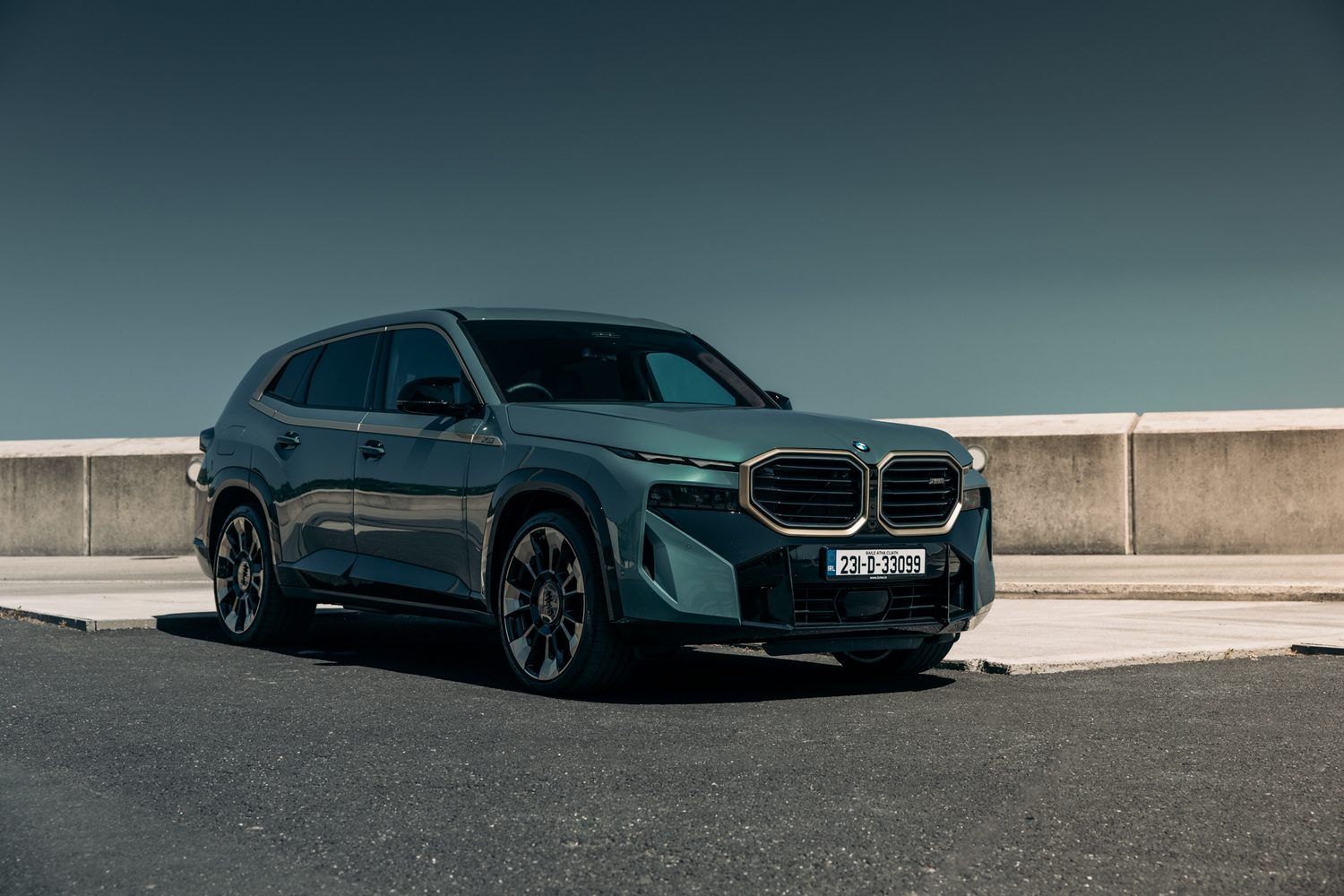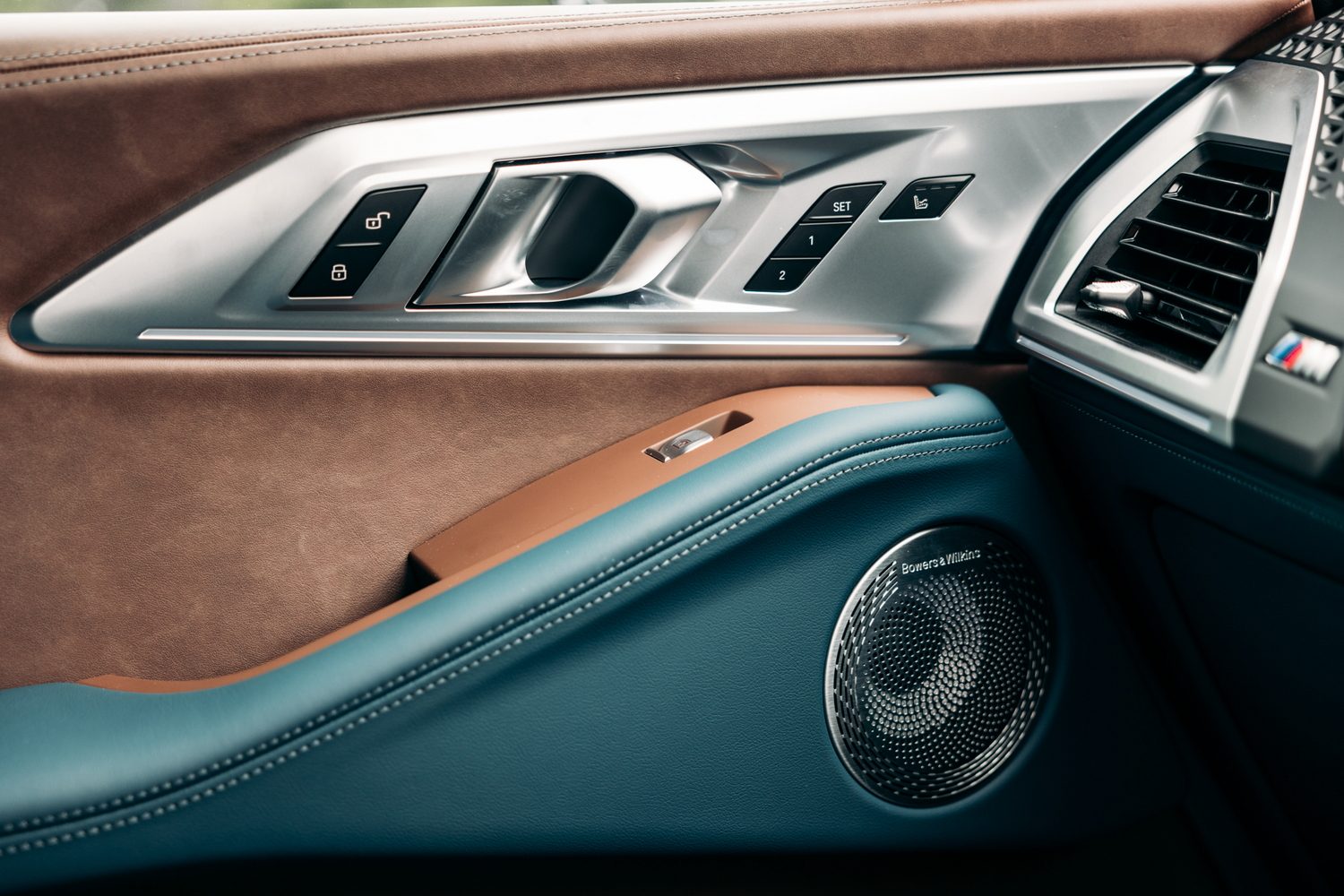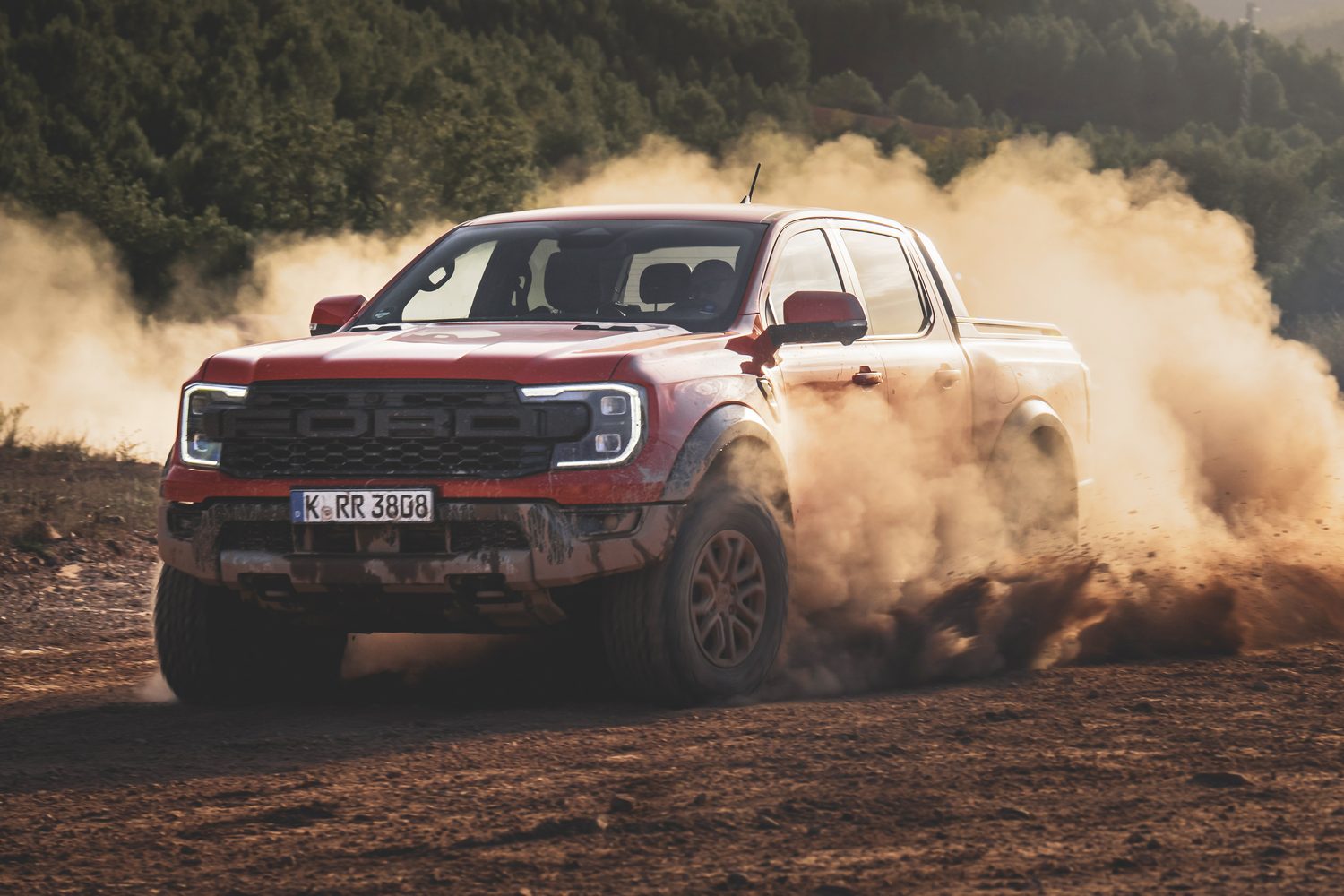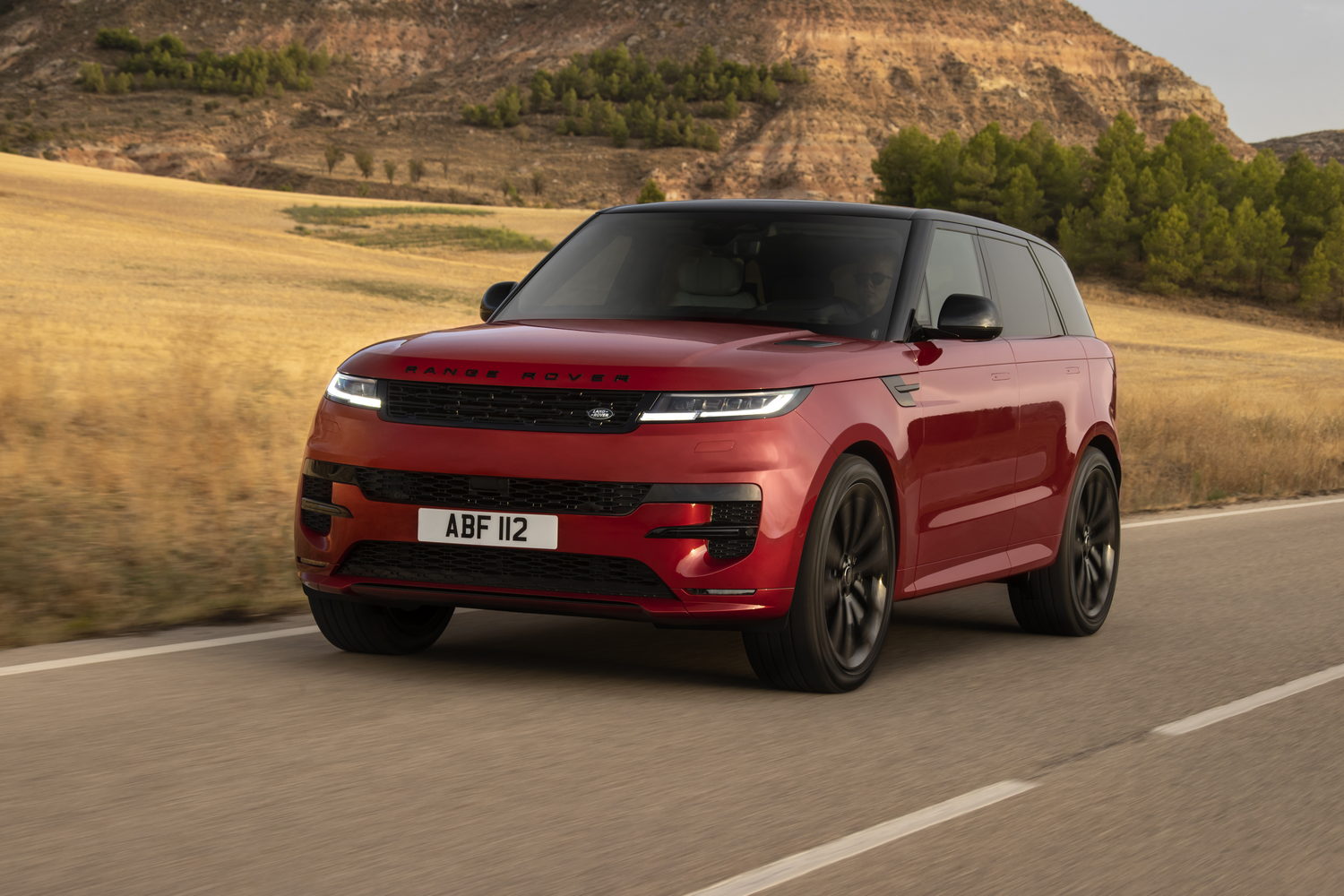BMW XM overview
The first BMW model that was made specifically to be an M car, as in not a modified version of any other production BMW, was the glorious M1 mid-engined coupe from the 1970s. This, the XM, is therefore only the second-ever BMW M-only car - there won't be a detuned version with a diesel engine, for instance. The XM was originally created to celebrated BMW M's 50th anniversary in 2022, and it's a big, incredibly powerful (more so if you go for the Red Label version) V8 plug-in hybrid SUV with dramatic styling inside and out.
To those that decry the mere fact that it's a large SUV, well when the M1 was built, the body style that was in fashion was the dart-nosed mid-engined coupe. Spool forward 40-some years and the body style that everyone wants is an SUV, so BMW would have been pretty foolish to base the XM on anything else.
Without question, the XM is a controversial looking car, which deliberately leans into its massive grilles (which light up at night) and its bulky, blocky styling. When you're standing next to it, it's not quite so massive (it's lower and a little shorter than a BMW X7 for instance) but it's never what you'd call subtle on the outside, especially with the gold trim and rather lovely 'Cape York Green' paint of our test car. The optional gold-and-black 23-inch wheels are possibly a bit much, but there's no denying the overall visual impact of the XM.
Vulgar? Well, maybe but as ever with these things, beauty is in the eye and all that and for all the opprobrium the car attracts on social media, everyone who came over to chat about the XM during our test drive seemed to like the way it looks. Equally, it has clearly not been designed for European tastes - BMW is chasing the wealth of American, Asian and Middle Eastern customers with the XM, where styling like this goes down better.
The BMW XM model range
The XM comes in a single trim, but with a choice of engine outputs. It's the same engine in both cases - a 4.4-litre V8 twin-turbo, closely related to the unit already in use in the BMWs M5, M8, X5 M and X6 M. That's tied into a plug-in hybrid system using a 145kW electric motor and a 25kWh (net useable) battery. The combined power output of the standard version, the one we're testing here, is a whopping 653hp and 800Nm of torque. Prices for this model start from €191,645.
Not enough power for you? Well, you can upgrade to the XM Red Label, which gets a distinctive red surround trim for the windows where our test car has a sweep of gold-coloured trim. Comparisons to the A-Team van if you buy a black-painted one aside, the XM Red Label is packing a massive 748hp from the same engine and hybrid system. Prices for that version start from €222,667.
Standard equipment on all XMs includes 21-inch alloy wheels (our test car wears optional 23-inch 'Bicolour Night Gold accent' wheels at €3,723), BMW Individual Merino leather interior, carbon-fibre trim, heated and ventilated front seats with massage function, heated rear seats, a Harman/Kardon surround-sound audio system, the lighting for the radiator grille, adaptive air suspension, soft-close doors, heated and cooled cupholders, active parking assistant, a head-up display and a wireless phone charger.
The options list is long and, as you can see from the €30,000 worth of extras fitted to our test car, potentially ruinous. Aside from the 23-inch wheels, our XM came with such options as a towbar (€1,624), the Driving Assistant Professional pack (which includes lane change warning, rear cross traffic alert, automated lane changing, adaptive cruise with stop-and-go, evasive manoeuvre steering and wrong way warning for €3,385), an upgraded Bowers & Wilkins stereo (€5,416), the M Driver's pack (which includes removing the speed limiter to raise the top speed to 270km/h, and a voucher for race track training offered by BMW Driving Experience, all for €3,046).
The BMW XM interior
If the XM's exterior is controversial, then the interior is quite possibly the car's strongest point despite the presence of a powerful, sonorous V8 engine. Given our test car's €200,000+ price tag, you might think it a disappointment that the cabin is full of generic BMW bits and pieces - from the big, sweeping dashboard screen to the steering column stalks and the minor switchgear - but actually it's not the case. Those parts simply become familiar touchstones in a cabin that, quite genuinely, can rival BMW's own subsidiary, Rolls-Royce, for outright luxury.
Almost all of the surfaces are covered in leather, which in our car was a combo of a 'Deep Lagoon' bluey-green leather to match the exterior with contrasting panels in a rich, almost untreated brown leather which looks as if it will wear rather beautifully over the years, forming a welcoming patina.
What's not leather is covered with a mixture of glossy carbon fibre or aluminium, and in the rare case where there's a plastic panel, it's one with a complex web-like pattern. Even the covers for the stereo speakers are actual metal, not merely painted plastic.
The seats, clearly inspired by those used in the BMW M5, are wonderfully comfortable and supportive, and strike just the right balance between being cosseting on a long journey and gripping you firmly when the road becomes twisty. The XM also gets the practical stuff right - the chilled and heated cupholders are mounted ahead of the stubby, leather-covered gear lever so bottles of drink don't get in your way when driving, and the door bins and storage space under the butterfly armrest are big enough to be useful.
All of the main driving controls - from that gear selector to the bright red start-stop button, the driving mode switch, and the button that makes the exhaust louder - are grouped on the centre console next to the familiar rotary controller for the iDrive infotainment system.
That iDrive system now lives on the vast, sweeping screen atop the dashboard - it's actually two separate screens: one for the driver's instruments and one for the infotainment system. The screens look big and impressively expensive. There's also a head-up display projected onto the windscreen.
On the steering wheel, there are the now-traditional M1 and M2 shortcut buttons, which allow you to pre-set them with engine, gearbox, suspension and other adjustable performance settings so that you can flick easily from, say, an all-quiet mode with everything turned down, to a full-on racetrack mode with everything turned up. There are also gorgeous carbon-fibre gearshift paddles.
In the back, the XM gets a plush, upholstered wraparound bench seat that's definitely reminiscent of the rear seats of a Rolls-Royce Ghost. Compared to the slightly confined cockpit-like layout of the front seats, the rear feels broad and expansive. Above you, the roof isn't a glass panel, but is instead covered with a soft suede-like material moulded in a 3D surface that looks almost like a computerised relief map. It's lit from all around by LEDs and is exceptionally tactile to touch.
There's lots of rear legroom and plenty of headroom, and instead of adjustable lumbar support, the XM comes with delightful little M-branded cushions, which you can slip neatly into the small of your back. There are rear air conditioning controls, of course, and a USB-C socket in the backs of each front seat. In spite of the high-backed front bucket seats, and the sharply-rising window line, the view out from the back is pretty good.
The boot is decent too, albeit a load volume of 527 litres up to the luggage cover is maybe not as massive as you might have expected, given the size of the exterior. By contrast, a BMW X7 M50i has 750 litres of boot volume in five-seat mode. And an extra set of rear seats.
The BMW XM driving experience
Right, this is what we're here for. This is an M car after all, and given its position in the BMW hierarchy, right now it's the ultimate M car. So thumb the Coca-Cola-red start button and drink in the... silence? Ah yes, of course, this is M's first plug-in hybrid, and you'd better get used to it, as the next M5 is going to use this same powertrain. For anyone thinking that an M car with a plug just isn't right, well there's a certain level of kinship between this V8+hybrid system and the V8+hybrid system in the dramatic new race car with which BMW is going to take on Le Mans next year.
Fully charged, the XM will do 88km on just the battery according to official numbers, which might be a slightly fanciful figure, but 70km certainly seems to be doable as long as you're not being silly with the accelerator. The only issue is that you can only charge at 7.4kW from a Type 2 connection - unlike a Range Rover PHEV, there's no DC fast-charging option.
In electric mode, the XM slinks around most agreeably. There's an artificial sound generator to warn pedestrians that you're coming towards them at low speed (although you'd think they might notice that the sun has become blotted out...) and that has been co-created by Hollywood movie music legend Hans Zimmer. Are you not entertained?
Right, enough of all this responsible electric driving stuff, let's see if the XM has what it takes to be a true M car.
Certainly, at first, it seems that way. When the V8 snaps into life, it does so with a proper smooth grumble at low speeds, like a NASCAR racer that's been to finishing school. Up the revs and it starts to howl like a bespoke racing engine. At which point you're seriously moving - 100km/h comes up in 4.3 seconds apparently, and that's a seriously impressive figure for a car lugging 2.7 tonnes around before you've even sat in it.
However, it's that weight that starts to literally drag on proceedings. Once you've had a couple of giggle-inducing stabs at the throttle, you do start to notice how much the weight (the same kerb weight as a seven-seat, diesel-engined 2003 Land Rover Discovery, incidentally) smothers the performance. The XM is still shatteringly, indecently fast, but you do start to twig that the engine is labouring, at times, to deliver that performance and that, after the initial hit of acceleration, performance does start to tail off. For example, the 0-200km/h time for the XM is 15.3 seconds. A BMW M5 CS, lighter by far and with no electric assistance, does the same sprint in 10 seconds. An academic figure to be sure, but an illustrative one.
What about handling? Well, with its adaptive suspension the XM handles pretty well, but that comes with the codicil of 'for something that weighs this much.' With 23-inch wheels, it was never going to ride gently, but surprisingly the ride quality isn't too bad, never getting worse than gently choppy.
The steering is beautifully weighted and accurate, and has quite good feel and feedback, and although almost all of the XM's prodigious weight is in exactly the wrong places, you can have fun hustling it through some challenging corners. It'll even drift a bit, if you really fancy (on track only, please...). The only downside, really, is that the sheer bulk means you can't exploit the handling nor the performance to the same extent as you could in a more compact M car.
Our verdict on the BMW XM
There will always be a good deal of polarised opinion about the BMW XM. From its styling to its size to its weight, it's a very Marmite car, and we're not going to try to decide who's right and who's wrong. What it is, though, is a hugely impressive piece of engineering, capable of astonishing feats of performance and handling, and with the sort of interior comfort and quality that you would - honestly - have to upgrade to a Rolls-Royce to better.
What do the rest of the team think?
For the record, I don't like the colour combination of the test car here, but the XM certainly has presence, and there are aspects of the design I hope to see in future BMWs. The interior, meanwhile, is sublime in an extravagant, indulgent way, just as it should be. The driving experience is plain odd. It's not like any other BMW M car, and not just because it's the first PHEV developed by the M division. It focuses more on long-distance comfort than it does rock-solid body control and it's not particularly good on a track. Still, it is a lot of fun, sound fantastic and I have no doubt that the target markets - i.e. not Ireland - will love it.
Shane O' Donoghue - Editor















































